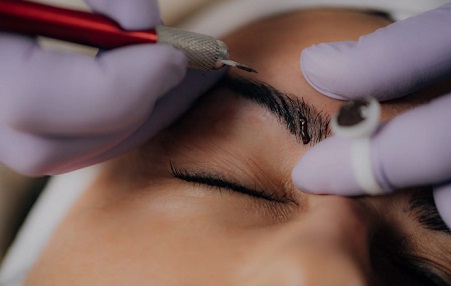WARNING! Individuals Undergoing Aesthetic Procedures Should Be Aware That Microblading And Other Beauty Regimens Can Cause Sarcoidosis!
Nikhil Prasad Fact checked by:Thailand Medical News Team May 13, 2024 11 months, 1 week, 6 days, 4 hours, 19 minutes ago
Aesthetics News: In recent years, the beauty industry has witnessed a surge in popularity for cosmetic procedures aimed at enhancing natural features. Microblading, in particular, has gained widespread acclaim as a semi-permanent solution for achieving fuller and more defined eyebrows. However, amidst the allure of flawless brows, a concerning issue has emerged - the potential link between microblading and systemic sarcoidosis, an autoimmune disease affecting multiple organs, including the lungs.

W
ARNING! Individuals Undergoing Aesthetic Procedures Should Be
Aware That Microblading And Other Beauty Regimens Can Cause Sarcoidosis
Recent
Aesthetic News coverages in various media covered the separate incidences of two women undergoing microblading procedures to enhance their looks ending up with a serious medical condition called Sarcoidosis that affected their lungs!
https://www.thesun.co.uk/health/27601932/women-hard-breathe-lung-disease-sarcoidosis-microblading/
https://indianexpress.com/article/lifestyle/health/microblading-causes-autoimmune-condition-lung-problems-in-2-women-should-you-ditch-the-treatment-9305746/
Understanding Microblading: Procedure, Risks, and Popularity
Microblading is a cosmetic technique that involves using a microblade tool to deposit pigments into the skin, mimicking the appearance of natural eyebrow hairs. The procedure is considered semi-permanent, lasting approximately 12 to 18 months, and is often sought after by individuals with sparse or thin eyebrows. Before the procedure, a numbing cream is applied to minimize discomfort, and the process typically takes around two hours to complete.
While microblading is generally regarded as safe, like any cosmetic procedure, it carries potential risks and complications. These can include allergic reactions to pigments, infections, and in rare cases, more serious adverse events.
The Unusual Cases: Microblading and Systemic Sarcoidosis
The connection between microblading and systemic sarcoidosis came to light through two rare but significant cases. Two women, both 33 years old, underwent microblading for their eyebrows and subsequently developed systemic sarcoidosis. This autoimmune condition is characterized by the formation of granulomas, or inflammatory cell clusters, in various organs such as the lungs, lymph nodes, skin, eyes, and heart.
The women initially noticed unusual "orange-red plaques" on their eyebrows following the microblading procedure. Concerned about these skin changes, they sought medical evaluation. Skin biopsies confirmed the presence of sarcoidosis, and further investigations revealed that th
e disease had also affected their lungs and lymph nodes.
Exploring the Link: How Microblading May Trigger Sarcoidosis
Medical experts analyzing these cases have proposed several theories regarding how microblading may trigger the development of sarcoidosis. One hypothesis suggests that the introduction of foreign materials, such as pigments, into the dermal or subcutaneous layers during microblading could potentially activate an immune response in susceptible individuals. This immune response may lead to the formation of granulomas characteristic of sarcoidosis.
It's important to note that while these cases highlight a possible association between microblading and sarcoidosis, further research is needed to fully understand the underlying mechanisms and establish causality definitively.
Understanding Sarcoidosis: Symptoms, Diagnosis, and Treatment
Sarcoidosis is a complex condition with a wide range of symptoms depending on the organs involved. Common symptoms include persistent cough, shortness of breath, skin rashes, swollen glands, fatigue, and joint pain. Diagnosis can be challenging due to the nonspecific nature of these symptoms, often requiring a combination of imaging tests, biopsies, and laboratory investigations.
Treatment for sarcoidosis focuses on managing symptoms and reducing inflammation. In mild cases, no treatment may be necessary as the condition can resolve on its own. However, in more severe or progressive cases, medications such as corticosteroids, immunosuppressants, and biologics may be prescribed to control the immune response and prevent organ damage.
Implications for Patients and Practitioners
The emergence of these rare but concerning cases underscores the importance of informed decision-making and risk assessment in aesthetic procedures. Patients considering microblading or similar treatments should be made aware of potential complications, however uncommon they may be. Additionally, healthcare providers and beauticians offering these services must stay vigilant for any adverse reactions and be prepared to address them promptly.
Recommendations for Patient Safety
-Educate patients about potential risks associated with microblading and other aesthetic procedures.
-Conduct thorough assessments of patient medical history and predisposing factors before performing microblading.
-Consider alternative options or treatments for individuals with a history of autoimmune conditions or sensitivities to foreign materials.
-Encourage open communication between patients and healthcare providers regarding post-procedure symptoms or concerns.
-Stay updated on medical literature and guidelines concerning the safety and efficacy of aesthetic procedures to ensure patient safety and well-being.
Conclusion: Balancing Beauty and Health
While microblading has revolutionized the beauty industry by offering a convenient solution for eyebrow enhancement, the recent cases linking it to systemic sarcoidosis serve as a reminder of the importance of cautious and informed decision-making in cosmetic procedures. By prioritizing patient safety, education, and ongoing research, healthcare providers, and clients can collaborate to minimize potential risks and promote the responsible practice of aesthetic treatments. As the beauty landscape continues to evolve, it's crucial to strike a balance between achieving aesthetic goals and preserving overall health and well-being.
The case reports of the two affected patients were published in the peer reviewed Journal of Medical Case Report.
https://jmedicalcasereports.biomedcentral.com/articles/10.1186/s13256-024-04439-w
Thailand
Medical News strongly advices that individuals wanting to undergo aesthetic procedures in Thailand or elsewhere, contact a reputable and experienced medical tourism agency.
For the latest news in the field of aesthetics, keep on logging to Thailand Medical News.
